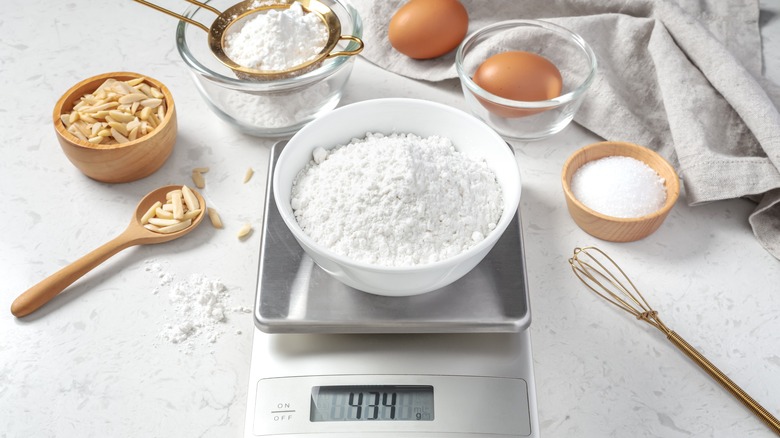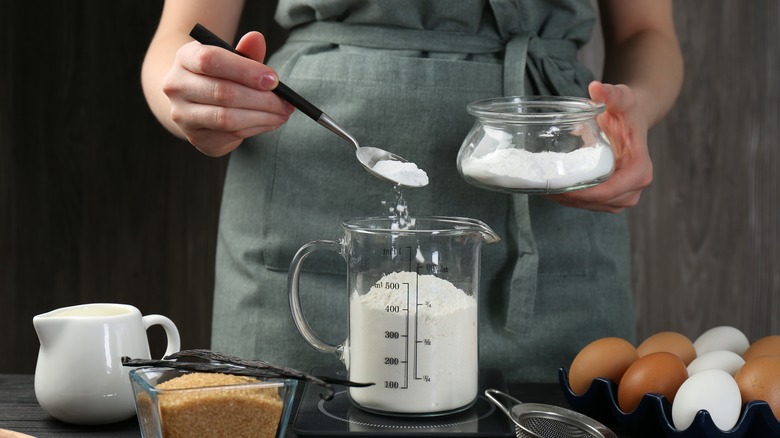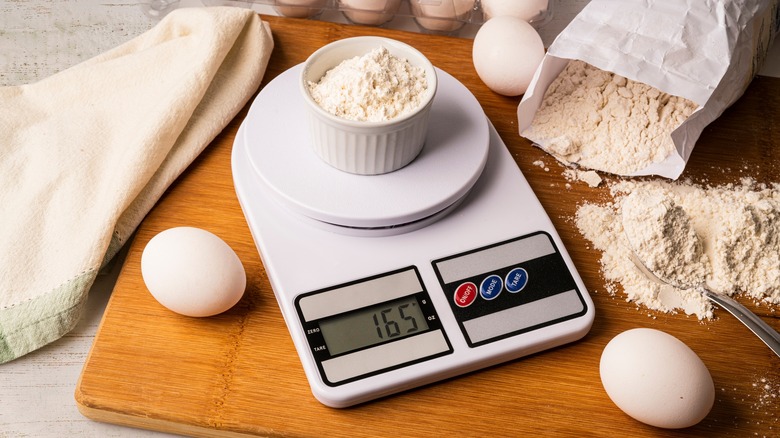Why A Digital Scale Is A Must-Have For Your Baking Projects
"Underconsumption core" is having a moment on the internet. And rightly so — the movement promoting using and buying less makes some pretty valid points. After all, there are tons of tools you just don't need in your kitchen arsenal, from pricy cookware (the vintage ones work just as well) to endless fancy gadgets, and the list goes on. One exception to this rule, however, is investing in a digital food scale — one of those kitchen tools that is actually very much worth it.
You'd probably never attempt to eyeball the weight of a package you were buying postage for, and as calorie-trackers know, guesstimation measurements are famously inaccurate. In the case of baking, exactness is also key, and for that, you need a good scale.
If you're looking to get into homemade bread baking, up your pastry-making game, or just make measuring for any old ingredient both more precise and easier to clean up, invest in the kitchen tool. You don't need anything fancy or spendy either — an under 15-buck option gets the job done. A quality scale is built to accurately measure wet or dry goods down to the measure of 1 gram — some will even measure down to an uber-precise .5 grams, completely eliminating the guesswork and room for error of eyeballing a cup of flour, for example, in that ancient plastic measuring cup you have.
Measuring cups can be far from precise
Why is exactness so important when it comes to baked goods? There are plenty of recipes and dishes where eyeballing and improvisation is fine — or even encouraged, with some chefs saying it's the key to making simple dishes stand out. But baking? It's a bit of an exact science. Being even a little off with your measurements of flour, salt, sugar, or leavening ingredients can spell disaster ... or at least dry cookies, soggy cakes, or flat breads.
Take measuring flour for example, sans scale. Are you dunking a measuring cup into a bag of flour and scooping it up? Adding spoonfuls to a measuring cup until you reach the top? Are you pouring an open bag of flour right into the cup? All three methods are common, and all three will result in totally different amounts of flour winding up in your bowl — even if you match the lines on your measuring cup. This doesn't even get into harder-to-measure ingredients like brown sugar, which might be packed, lightly packed, or not at all. And what one baker considers packed versus another isn't even quantifiable, so it's easy to wind up with wildly fluctuating amounts depending on your style.
Finally, what about when we're halving or doubling a recipe, converting it from metric to imperial, or eyeballing out a half-cup of sugar using a measuring cup? All situations when even the most practiced of bakers can end up with far from precise measurements.
Tips for choosing and using your food scale
First things first, choose yourself a good scale — which doesn't have to mean an expensive one. The average home cook doesn't need to shell out tons for a scale that gets the job done. Just make sure it's a digital one, meant for food measuring. Be sure to consider the project at hand when choosing your model. Some scales go up to larger weight capacities, which can be handy if you're making large, commercial-sized batches of something, but likely won't be necessary for the typical home cook. While almost all modern scales do this, be sure your scale gives measurements in both metric and imperial, which can be handy depending on the recipe you're following.
Once you're ready to bake, put your bowl or container on the scale, choose the unit of measurement (grams, ounces, fluid ounces, etc.), and be sure to hit the "tare" button. This function is a crucial one that removes the weight of the container or bowl you set on the scale, so you're only measuring the addition of the ingredient, not the vessel.
Because you can hit tare between each step — after you add flour, then sugar, and again before baking soda, for example — you could even mix everything in one bowl without dirtying a single measuring cup or teaspoon, so long as you zero out between steps. Fewer dishes and perfectly made cakes, bread, and cookies that taste chef-made? We're here for it.


